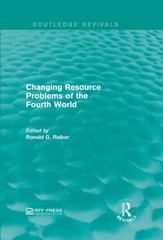Question
REview the case study -case study and questions While various defluoridation techniques have been explored, each has its limitations. Existing techniques are often too costly
REview the case study
-case study and questions
While various defluoridation techniques have been explored, each has its limitations. Existing techniques are often too costly (because the geographic areas prone to fluorosis are among the poorest regions on the planet), ineffective or even dangerous (some of the remediation processes add other contaminants to the water). The main techniques that have been, and continue to be, investigated with varying degrees of success include: adsorption, precipitation, ion exchange and membrane processes.[6]
Adsorption can be achieved with locally available adsorbent materials with high efficiency and cost-effectiveness. Cost-effective and locally-available herbal and indigenous products offer promising options. The process is dependent on pH and the presence of sulfate, phosphate, and bicarbonate which results in ionic competition. Disposal of fluoride-laden sludge is problematic.
Precipitation is the most well-established and most widely used method, particularly at the community level. However, it has only moderate efficiency and a high chemical dose is required. Excessive use of aluminum salts produces sludge and adverse health effects through aluminum solubility.
Ion Exchange removes fluoride up to 90-95% and retains the taste and colour of the water. Sulphates, phosphates, and bicarbonates also result in ionic competition in this method. Relatively high cost is a disadvantage and treated water sometimes has a low pH value and high levels of chloride.
Membrane processes are effective technique and do not require chemicals. It works at wide pH range and interference by other ions is negligible. Negatives include higher costs and it skilled labour. This process is not suitable for water with high salinity.[2]
Calcium amended-hydroxyapatite is the most recent defluoridation technique in which aqueous calcium is amended to the fluoride contaminated water prior to contact with uncalcined synthetic hydroxyapatite adsorbent.[7] In this novel defluoridation technique, amending aqueous calcium successfully prevents the dissolution of hydroxyapatite during the defluoridation and also enhances the defluoridation capacity of hydroxyapatite. In addition to these features, this calcium amended-hydroxyapatite defluoridation technique provides calcium-enriched alkaline drinking water and drinking of this defluoridated water may also help in fluorosis reversal. Thus, it is expected that utilization of this defluoridation technique to provide safe drinking water helps in the mitigation of fluorosis.
questions
1.elaborate on the Thermophoresis as made sense of by temperature angle, the spray particles move from higher temperature locales 2.justify this proclamation; Vapor strain about a bead increments with decline in measurement of the drop
3.how is the 1 micron credited to the size of spray particles formation?explain 4. Development of vapor sprayers by nucleation produces particles of size 5.enumerate all the unique combination part of the Fluorex 6. Which material is utilized for eliminating fluorides from hard water containing 3ppm of fluorides? 7.show the request for occasions that add to the expulsion of fluorides in the contact channels 8. One cubic meter of bone can treat how much amount of water containing 3.5 ppm of fluoride?show your working 9.propose the scope of temperatures that associate to the defluoridation with calcium phosphate during carcination 10. Which isn't utilized for defluoridation?
Step by Step Solution
There are 3 Steps involved in it
Step: 1

Get Instant Access to Expert-Tailored Solutions
See step-by-step solutions with expert insights and AI powered tools for academic success
Step: 2

Step: 3

Ace Your Homework with AI
Get the answers you need in no time with our AI-driven, step-by-step assistance
Get Started


